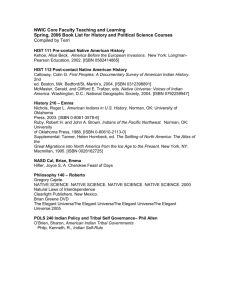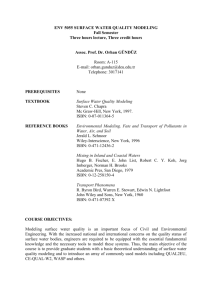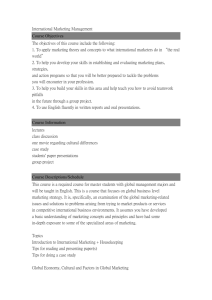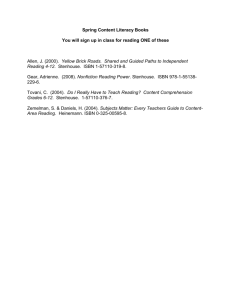Novels, Short Stories, Plays
advertisement
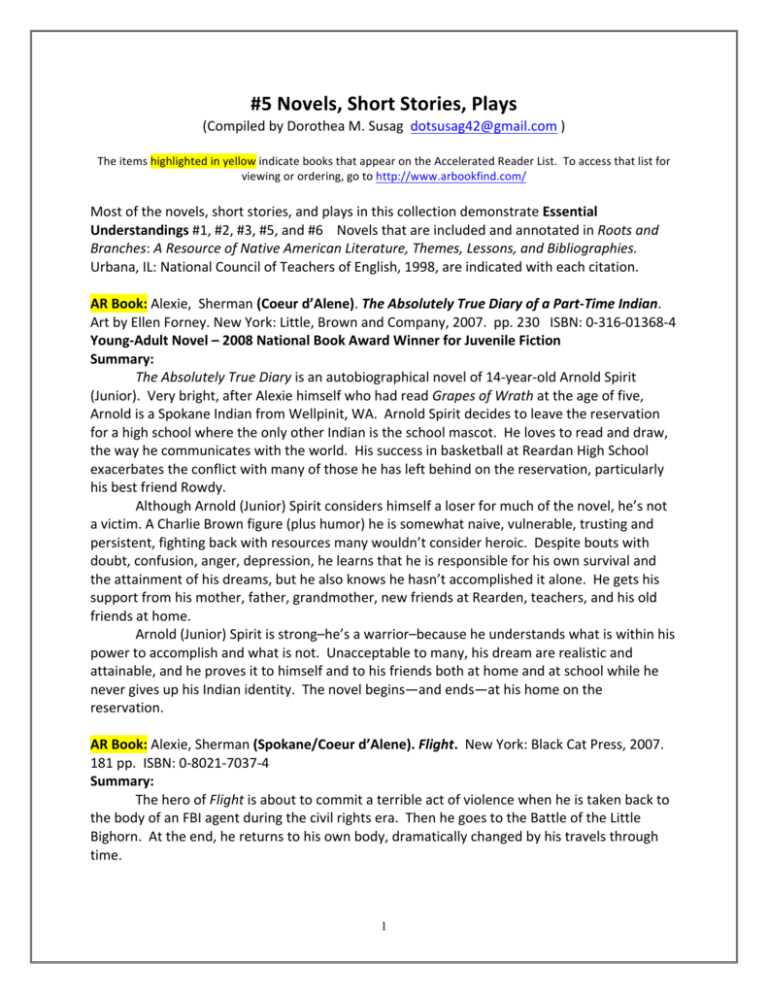
#5 Novels, Short Stories, Plays (Compiled by Dorothea M. Susag dotsusag42@gmail.com ) The items highlighted in yellow indicate books that appear on the Accelerated Reader List. To access that list for viewing or ordering, go to http://www.arbookfind.com/ Most of the novels, short stories, and plays in this collection demonstrate Essential Understandings #1, #2, #3, #5, and #6 Novels that are included and annotated in Roots and Branches: A Resource of Native American Literature, Themes, Lessons, and Bibliographies. Urbana, IL: National Council of Teachers of English, 1998, are indicated with each citation. AR Book: Alexie, Sherman (Coeur d’Alene). The Absolutely True Diary of a Part-­‐Time Indian. Art by Ellen Forney. New York: Little, Brown and Company, 2007. pp. 230 ISBN: 0-­‐316-­‐01368-­‐4 Young-­‐Adult Novel – 2008 National Book Award Winner for Juvenile Fiction Summary: The Absolutely True Diary is an autobiographical novel of 14-­‐year-­‐old Arnold Spirit (Junior). Very bright, after Alexie himself who had read Grapes of Wrath at the age of five, Arnold is a Spokane Indian from Wellpinit, WA. Arnold Spirit decides to leave the reservation for a high school where the only other Indian is the school mascot. He loves to read and draw, the way he communicates with the world. His success in basketball at Reardan High School exacerbates the conflict with many of those he has left behind on the reservation, particularly his best friend Rowdy. Although Arnold (Junior) Spirit considers himself a loser for much of the novel, he’s not a victim. A Charlie Brown figure (plus humor) he is somewhat naive, vulnerable, trusting and persistent, fighting back with resources many wouldn’t consider heroic. Despite bouts with doubt, confusion, anger, depression, he learns that he is responsible for his own survival and the attainment of his dreams, but he also knows he hasn’t accomplished it alone. He gets his support from his mother, father, grandmother, new friends at Rearden, teachers, and his old friends at home. Arnold (Junior) Spirit is strong–he’s a warrior–because he understands what is within his power to accomplish and what is not. Unacceptable to many, his dream are realistic and attainable, and he proves it to himself and to his friends both at home and at school while he never gives up his Indian identity. The novel begins—and ends—at his home on the reservation. AR Book: Alexie, Sherman (Spokane/Coeur d’Alene). Flight. New York: Black Cat Press, 2007. 181 pp. ISBN: 0-­‐8021-­‐7037-­‐4 Summary: The hero of Flight is about to commit a terrible act of violence when he is taken back to the body of an FBI agent during the civil rights era. Then he goes to the Battle of the Little Bighorn. At the end, he returns to his own body, dramatically changed by his travels through time. 1 AR Book: Alexie, Sherman (Spokane/Coeur d’Alene). Indian Killer. New York: Warner Books, Inc. 1996. 420 pp. ISBN: 0-­‐446-­‐67370-­‐6 Summary: Born on some unnamed Indian reservation to a fourteen-­‐year-­‐old girl, the baby is taken by a man in a white suit to a helicopter who delivers the newborn to his adoptive parents, Olivia and John Smith in Seattle. Knowing nothing about his specific heritage, they try to expose him to all they know about Indians. Still John Smith never really bonds with neither his parents nor anyone else, and he becomes more and more isolated and alienated as he struggles to understand himself and what made everything go wrong. When he encounters other Indians, their behavior surprises him because these “real Indians” differ so much from what he’s learned from his adoptive parents. An ironworker on the last skyscraper in Seattle, John Smith quits his job and looks for someone to blame and kill for all the pain in the Indian world he feels and sees. Although some reviewers have called this a serial killer mystery, it is less about an Indian who kills and more about those who kill Indians both past and present. Marie is an activist student who serves sandwiches to the homeless and challenges her professor and an author who purports to be Indian. Jack Wilson is the author who claims to be Indian and wants to use the Indian Killer story as the subject of his latest novel, believing that as a fiction writer he can make up whatever he wants. Truck Smith is the virulent radio talk-­‐show host who spews racist opinion and stirs up anti-­‐Indian sentiment that results in city-­‐wide random violence against Indians. Most disturbing are the revelations about Indian/white relationships and racism, and the perpetuation of misbeliefs about Indians that have killed Indians for five centuries. AR Book: Alexie, Sherman (Spokane/Coeur d’Alene). The Lone Ranger and Tonto Fistfight in Heaven. New York: Atlantic Monthly Press, 1993. 223 pp. ISBN: 0-­‐06-­‐097624-­‐1 (Roots and Branches 141) AR Book: Alexie, Sherman (Spokane/Coeur d’Alene). Reservation Blues. New York: Atlantic Monthly Press, 1995. 306 pp. ISBN: 0-­‐98113-­‐504-­‐9 Summary: Thomas Builds-­‐the-­‐Fire is a Spokane Indian storyteller who is given an enchanted guitar by blues legend Robert Johnson. Believing in its magic, Thomas builds an all-­‐Indian Catholic band called Coyote Springs, and they travel from reservation bars to New York, to Seattle, and on a soul search themselves. Alexie, Sherman (Spokane/Coeur d/Alene). The Toughest Indian in the World. New York: Grove Press, 2000. 208 pp. ISBN: 0-­‐8021-­‐3800-­‐4 Summary: In this collection of short stories, the narrator’s comment in the first story is proved over and over: “race, whatever its construction, is real.” Living with this reality, characters look for love as they try to define it for themselves. They save each other and themselves, and their dreams profoundly affect the choices they make. The story “The Sin Eaters” forces a comparison and contrast between the experience of Indians in America with the Jews in Germany and Poland. All of the stories and characters support or contradict popular beliefs 2 about Indians. The last story entitled “A Good Man” repeatedly asks and answers the question: “What is an Indian?” One answer? “A man who keeps his promises.” The protagonist is a young man who takes care of his father, a terminally ill diabetic whose leg has just been amputated. The father has never been to California, never been to Mexico. So they leave and head for all the towns between Wellpinit Washington and Mexico. After the last “what is an Indian?” question, the narrator says, “I lifted my father and carried him across every border.” It is the definition of the title in a very fine story. Readers might find some of the more graphic or intimate details in these stories disturbing, but the stories themselves build understanding of love and human need while they provide opportunities for readers to move beyond their own religious or cultural constructs. Alexie, Sherman (Spokane/Coeur d/Alene). War Dances. New York: Grove Press, 2009. 209 pp. ISBN: 978-­‐0-­‐8021-­‐4489-­‐8 Pen/Faulkner Award Summary: Some of the collection of 23 short stories and poems: • “The Limited” – a poem ending with “Why do poets think/They can change the world?/The only life I can save/Is my own.” 1-­‐2 • “Breaking and Entering” 3-­‐19 When a black teen breaks into the house of a film editor (Spokane Indian, but the media thinks he’s white), he picks up his son’s metal bat and kills the intruder. One impression: everyone edits and shapes events in their lives to fit their view of the world. • “Go, Ghost, Go” 21-­‐22 A poem about those obsessed with those who have killed. • “After Building the Lego Star Wars Ultimate Death Star” 25 Boys think that their “joyful wars” can turn them “into gods.” • “War Dances” 29-­‐63 A short-­‐story, poem, memoir, particularly about his temporary loss of hearing and doctors and fear of death, about his father’s life and death, and about his grandfather’s war death. Metaphorically, it’s about ways we challenge and survive the demons of life. • “Ode to Small-­‐Town Sweethearts” 73-­‐74 The speaker drives through snow and ice, following a snowplow, at 3 a.m. For what? “For a girl.” “Mortals have always fought the gods/And braved epic storms for love and/or lust.” • “The Senator’s Son” 77-­‐103 A young attorney and his friends beat up a couple of gay men, and he soon realizes one of them, Jeremy, is his best friend from high school. The attorney is the son of a senator, who is his “hero because of his strict moral sense.” But now that senator is running for reelection, and he tells his son to lie, to say it was the gay men who started the fight. In the end, Jeremy, whose father beat him and broke his arm when he learned Jeremy was gay, teaches the young attorney, so disillusioned with his father, to forgive his father as Jeremy did his own. • “Another Proclamation” 105-­‐106 In 1862, contradicting President Lincoln’s generous Emancipation Proclamation, President Lincoln “approved the order for the largest public execution in United States history,” to hang 38 Sioux for uprisings against the State in Mankato, Minnesota. 3 • • “On Airplanes” 149-­‐151 The speaker is “amused” and clearly disturbed when couples what him to trade seats so they can sit together. The request is “imperial” and “colonial,” but “for somebody else’s love,” he always does give up his seat. “Looking Glass” 187-­‐188 Chief Joseph who said he would “fight no more forever” and then went on to watch and lead his people for 27 more years, until the speaker says he died of depression. But near the end, he would braid the speaker’s grandmother’s hair. Although those words were not his last, perhaps they were the final statement of his life. AR Book: Bruchac, Joseph (Abenaki/Slavic). March Toward the Thunder. New York: Penguin Books, 2008. 290 pp. ISBN: 978-­‐0-­‐14-­‐241446-­‐0 Summary: Louis Nicolette is a fifteen-­‐year-­‐old Abenaki Indian who is recruited—because he can pass for 20-­‐-­‐to fight for the Union in 1864, along with Artis, a Mohawk. Based on years of reading and research, the novel is based on fact, although the protagonist is fictional. However, Bruchac’s great grandfather, Louis Bowman, fought with the Irish Brigade (like Louis Nicolette) and nearly died in the Civil War. With detailed descriptions of real battles and the suffering of thousands and thousands of men—and women, the novel also provides perspectives of General Grant and the Irish that probably would contradict much of the popular belief of the day. Sergeant Flynn explains to Louis the “deeper bond” between the Irish and the Indians: “It’s the cloth of history into which we’ve both been sewn, the red-­‐haired Irishman and the red-­‐skinned Indian. Put those histories side by side and it’ll be the thing itself and its image in the mirror.” Both peoples suffered similar fates at the hands of the English.(123) Bruchac, Joseph (Abenaki). Foot of the Mountain and other stories. Illustrations by Chris Charlebois. Duluth, MN: Holy Cow! Press, 2005. 135 pp. ISBN: 0-­‐930100-­‐62-­‐X Summary: In Part One, Foot of the Mountain includes traditional myth, science fiction, and short stories. Part Two includes fine-­‐crafted narrative and expository essays about the value of traditional stories and values in American culture and society today, and the journal entries provide insight into the Abenaki Indian family life and culture that Bruchac learned from his grandparents. While a few stories contain some sensitive sexual material, teachers may read aloud the following short stories to students ranging from 13 and up: • “Sounds of Thunder” 9-­‐15 A story rooted in Bruchac’s heritage where his fifteen-­‐year-­‐ old great-­‐grandfather, Lewis Bowman, Abenaki, lies about his age and enlists in the Union army during the Civil War. There he meets and makes friends with an “enemy,” Artis, a Mohawk boy, who also has enlisted to fight for the Union. • “Gifts” 17-­‐23 In 1930, Emma is a bright Abenaki teen selected to attend the Hampton Indian Boarding School in Virginia because she is gifted academically and musically. When she arrives in Virginia, she experiences segregation for the first time and meets a black porter who sympathizes with her loneliness. He says, “you got to carry your home with you wherever you go.” As she leaves the train station, she honors him and calls him “grandfather,” and then gives him her corn husk doll as a gift in return for his kindness. 4 • • • • “Bear Child” 25-­‐29 A contemporary story of the son of a black bank guard and an Abenaki mother. After his father is shot and killed, the boy cares for his grieving mother alone until a social worker takes her to treatment and takes the boy to his mother’s loving relatives who live away from the city and near the woods. “Mamakaden: Foot of the Mountain” 31-­‐41 A story of Mamakaden (Ojibwe), an old woman and a huge hairy man—Bigman—who care for each other and protect the forest on the edge of a national park as surveyors try to enlarge the boundaries of the park into Indian land. “A Panther in the Attic” 43-­‐51 The story of Russell Painter, a hung-­‐over Desert Storm veteran, and Grama Big Eel, who runs a store on the reservation. In the night, she has sent him a frightening dream about a panther. And now in her store, as he bends over to push a log into the fire in her store, she stands over him with an eagle feather to inspire him to fight for his people against the Deer Haven development that is encroaching on their land and reservation. “Growing Season” 53-­‐57 Science Fiction, “Growing Season” begins with a story of the first human beings made out of stone and then the ash of trees. The narrator, a descendant of the Lenape people on earth, lives on “the fourth planet of K-­‐Vega-­‐7.” There the indigenous people, The Greenies, suffer under similar encroachment, philosophies, and environmental destruction as America’s early Native people, and they can’t live apart from their forests. But after Old Nest Woman appears to the narrator, a new dawn arises and “from the graves of those who were planted there, were trees.” Essays: • “Seeing the Circle:The Wisdom of Native Stories” 83-­‐90 In this essay, Bruchac refers to specific Native stories as they relate to environmental issues. • “The Truth of the Telling” 91-­‐94 After viewing the clear-­‐cut rain forests along the Amazon, and after listening to a Mayan storyteller, Bruchac and his son realize again “the power of story to transform, to teach, and to inspire. But I cannot think of another time when the contrast was as clear between the life of story, the vitality the story gives and guards, and the ultimate emptiness of the tales told by advertising, light-­‐quick narratives holding no more morality higher than corporate profit(93).” • “At the End of Ridge Road: From a Nature Journal” 95-­‐109 In these journals, Bruchac remembers the value of animals to the Abenaki people through traditional story and experience, and he celebrates the return of nature’s animals to their homes. • “For the Little People” 111-­‐116 Bruchac recalls experiences where others have told him about seeing the Little People: “widespread belief in the Little People, often described as ‘Little Indians dressed in old-­‐time clothes,’ is one of the enduring cultural artifacts of the New England tribes(112).” • “The SnappingTurtle” 117-­‐127 As a young boy, Bruchac goes to the Greenfield Reservoir and spies a snapping turtle moving toward the sandy bar. Catching it by the tail, he brings it back to his grandparents who suggest he might sell it. But young Joseph changes his mind, and his grandfather asks him why the turtle was heading for the sand—to lay her eggs, of course. A good story. 5 • • “Tickling a Trout” 129-­‐132 When Joe’s father criticizes his inability to catch a fish with a pole, Grandfather showed him “how to tickle a trout, how to coax it into your hands and lift it out of the water(131).” After asking the trout to trust him, he lets it go. And that’s how has caught and released fish all his life. “Hollyhocks” 133-­‐135 Like little Joe Bruchac, hollyhocks grow to the height of a tall man from “little seeds, flat as tiny pale coins(134).” Campbell, Maria (Metis). Halfbreed. Lincoln: University of Nebraska Press, 1973. 154 pp. ISBN: 0-­‐8032-­‐6311-­‐2 (Roots and Branches 148) Cook-­‐Lynn, Elizabeth(Crow Creek Sioux). The Power of Horses and Other Stories. New York: Arcade Publishing, 1990. 131 pp. ISBN: 1-­‐55970-­‐050-­‐5 Summary: Within these stories, people living on the reservation suffer grief when sons fight in foreign wars, when alcoholic mothers lose their children, and when the white man's injustice prevails. But the stories are also filled with "beauty, gentleness, charm and humor." One particular story, "Flight," is a story about Velma, a young Indian woman who has made a life for herself off the reservation. On the way home to visit her dying mother, she struggles with-­‐-­‐and resolves-­‐-­‐a conflict over her responsibility to her Indian family. These people survive because they are connected for ages, like grandmothers and granddaughters, through traditional spirituality and through the values of relatives and elements of the earth. The stories are short and are best read aloud, but secondary students enjoy reading the collection independently. Deloria, Ella Cara (Yankton Sioux). Waterlily. University of Nebraska Press, 1988 244 pp. ISBN: 0-­‐8032-­‐6579-­‐4 Essential Understandings #1, #2, #3, #4, #5, #6 Fiction Grades 7 and up Summary: First written in 1944, this mid-­‐nineteenth-­‐century novel provides insight into the traditional Dakota customs, rituals, and values of the Old Ways while it tells the story of Waterlily, a Dakota girl. With a female protagonist, Waterlily works well in conjunction with James Welch’s Fools Crow, especially since both represent the cultural and personal loss and survival of mid-­‐ to-­‐late nineteenth-­‐century Plains Indians. (Roots and Branches 153) AR Book: Dorris, Michael (Modoc). A Yellow Raft in Blue Water. New York: Henry Holt, 1987. 342 pp. ISBN: 0-­‐8050-­‐0045-­‐3 (Roots and Branches 154) Earling, Debra Magpie (Salish/German). Perma Red. New York: BlueHen Books, 2002. 296 pp. ISBN: 0-­‐399-­‐14899-­‐X Summary: Winner of the 2003 Spur Award for “Best Novel of the West,” Perma Red is set in the 1940's on the Flathead Reservation in Western Montana. The novel unwinds the story of the troubled and beautiful Louise White Elk and the people who try to save her. Hungry for home and freedom, Louise is attracted to and repelled by three powerful and dangerous men who 6 want her. Through memory, where one story springs from another like gossip, and in visions of land and a place, we see how one person can affect a whole community. Louise makes her own choices and survives: where and how she’ll live, what she’ll value, and whom she’ll trust and love. While others try to save or capture her, ultimately, she prevails because she frees and saves herself. The novel began as a biographical endeavor and then evolved scene by scene, or “moments of being,” rather than exposition. Debra’s Aunt Louise, the protagonist of the novel, was twenty-­‐ three when she died. In the Summer 2002 issue of Barnes and Noble’s’ “Discover Great New Writers,” Perma Red appears as one of fifteen exceptional books recommended by their critical reading group. AR Book: Erdrich, LouIse (Chippewa). Beet Queen. New York: Holt, Rinehart, and Winston, 1986. 338 pp. ISBN: 0-­‐8050-­‐0058-­‐5 Summary: The novel begins in the spring of 1932 when Karl Adare and his sister, Mary, eleven, arrive in Argus, North Dakota. Since their mother has abandoned them they are here to look for her sister, Aunt Fritzie, who runs a butcher shop with her husband. This is Mary’s story over forty years in a community where the sugar beet industry is growing, and her drams and fantasies play a significant role throughout the novel. Erdrich, LouIse (Chippewa). Love Medicine. New York: Holt, Rinehart, and Winston, 1984. 275 pp. ISBN: 0-­‐03-­‐070611-­‐4 (Roots and Branches 157) Erdrich, Louise (Chippewa). The Last Report on the Miracles at Little No Horse. New York: Harper Collins, 2001. 361 pp. ISBN: 0-­‐06-­‐018727-­‐1 AR Book: Erdrich, Louise (Chippewa). The Master Butchers Singing Club. New York: Harper Collins, 2004. 388 pp. ISBN: 0-­‐06-­‐093533-­‐2 Erdrich, Louise (Turtle Mountain Chippewa/German). The Round House. New York, NY: Harper Collins, 2012. Review: Louise Erdrich’s outstanding New York Times bestseller was the 2012 National Book Award winner—an amazing but not surprising achievement for an author of fourteen novels, six books for children and young adults, two nonfiction works, and numerous short stories. This one differs from Erdrich’s other novels because it features the adult perspective of a single protagonist, Joe, who remembers his thirteenth summer on their Ojibwe reservation in North Dakota. His father is a tribal judge with a law degree, and his mother, Geraldine, is a tribal enrollment specialist who keeps track of tribal memberships, enrollment issues, and the placement of adopted children. The novel opens as Joe and his father pry loose stray tree sprouts that would break the foundation of the house—a metaphor for the event that nearly breaks apart the family and community. Geraldine leaves to retrieve a file for someone who has called her. And when she finally returns, she’s bleeding and grief stricken. 7 The story of the rape and abuse and subsequent efforts to identify and prosecute the killer, as well as how his father and mother react to the trauma, are all viewed through the eyes and ears of Joe. The reader only knows Geraldine’s suffering and the events that preceded and followed through Joe, a confused, frustrated, and determined early teen, who only wants their world and his "before mother" to return to “normal.” The complete review is featured at Humanities Montana website: http://www.humanitiesroundtable.org/forum/topics/louise-­‐erdrich-­‐s-­‐round-­‐house-­‐a-­‐review-­‐ and-­‐invitation-­‐to-­‐comment Erdrich, Louise (Chippewa). Tracks. New York: Henry Holt and Company, 1988. 226 pp.(Roots and Branches 158) Gansworth, Eric (Onondaga). Indian Summers. East Lansing, MI: Michigan State University Press, 1998. 200 pp. ISBN: 0-­‐87013-­‐479-­‐5 Essential Understandings: #1, #2, #4, #5, #6 Summary: Raised on the Tuscorara Reservation, Gansworth has written a novel that reflects the history and culture of this place. The protagonist, Floyd, has kept his memories of summer from his early childhood until the present, and the details make a superb story. In Indian Summers; readers share Floyd’s grief and the ways he survives; readers laugh out loud at memorable episodes that want retelling and rereading; readers are lead to question the assumptions non-­‐Indians make about Indians and the reservation. We see how Floyd makes compromises in order to survive. Ultimately the novel answers the question: Why do Indians continue to live on the reservation? Because there is community and there is hope. The last lines of each chapter in Indian Summers are profound, inviting the reader into further reflection on the chapter’s theme and story. Hale, Janet Campbell. (Coeur d’Alene). Bloodlines. New York: Harper Collins, 1993. 187 pp. ISBN: 0-­‐06-­‐097612-­‐8 Hale, Janet Campbell. (Coeur d’Alene). Jailing of Cecilia Capture. New York: Random House, 1985. 198 pp. ISBN: 0-­‐8263-­‐1003-­‐6 (Roots and Branches 160) Hogan, Linda (Chickasaw). Mean Spirit. New York: Ivy, 1990. 377 pp. ISBN: 0-­‐8041-­‐0863-­‐3 (Roots and Branches 162) Hogan, Linda (Chickasaw). Power. New York: W.W. Norton & Company, 1998. 234 pp. ISBN: 0-­‐ 393-­‐31968-­‐7 King, Thomas (Cherokee). Green Grass, Running Water. Boston: Houghton Mifflin, 1993. 469 pp. ISBN: 0-­‐533-­‐37368-­‐4 (Roots and Branches 164) King, Thomas (Cherokee). One Good Story, That One. Canada: HarperCollins, 1993. 147 pp. ISBN: 0-­‐00-­‐648525-­‐1 8 Summary: A collection of ten stories previously published and told in first person narrative, one of the story, “Borders,” is about a Blackfoot woman who wants to cross the border at Sweetgrass to visit her daughter in Utah. The border patrol agent asks her citizenship, and she says “Blackfoot.” On either side, the agents refuse to accept anything other than Canadian or American, so she and her son are stuck in the middle. They sleep in their car and visit the Duty Free shop for entertainment. The next morning, the media gets ahold of the story. With no hesitation, the guard decides to accept “Blackfoot and the woman and son are allowed to cross with no hassle. It’s an identity story, a story of persistence and certainty, and it’s a story about the power of a woman to beat the system. King, Thomas (Cherokee).Truth and Bright Water. New York: Grove Press, 1999. 267 pp. ISBN: 0-­‐8021-­‐3840-­‐3 Highway, Tomson. (Pelican Narrows Indian Reserve in Northern Saskatchewan). The Rez Sisters: A Play. Saskatoon, Sasketchewan: Fifth House, 1988. 118 pp. ISBN: 0-­‐920079-­‐44-­‐X Least-­‐Heat Moon, William (Osage/Irish,English). Blue Highways: A Journey Into America. Photographs by the author. New York: Fawcett Crest, 1982. 435 pp. ISBN:0-­‐449-­‐20432-­‐4 Marshall, Joseph M. III (Lakota). Hundred in the Hand. Golden, CO: Fulcrum Publishing, 2007. 371 pp. ISBN: 978-­‐1-­‐55591-­‐653-­‐4 Summary: This is first in a series of Lakota Westerns. It’s historical fiction, the story about the “Fetterman Massacre” of 1866 from the Lakota perspective. Marshall, Joseph M. III (Lakota). Long Knives are Crying. Golden, CO: Fulcrum Publishing, 2008. 371 pp. ISBN: 978-­‐1-­‐55591-­‐672-­‐5 Summary: This is second in the series of Lakota Westerns by Marshall. Taking place ten years after the “Hundred in the Hand,” it tells the story of the Battle of the Rosebud, of Sitting Bull gathering the People, the Battle of the Little Bighorn (the Greasy Grass battle) and the defeat of General George Custer. McNickle, D’Arcy (Salish/Metis). The Hawk is Hungry and Other Stories. Brigit Hans, ed. Tucson: University of Arizona Press, 1992. 179 pp. ISBN: 0-­‐8165-­‐1331-­‐7 (Roots and Branches 168) McNickle, D’Arcy (Salish/Metis). The Surrounded. Albuquerque, NM University of New Mexico Press, 1936. ISBN: 0-­‐8263-­‐0469-­‐9 (Roots and Branches 169-­‐170) McNickle, D’Arcy (Salish/Metis). Wind From an Enemy Sky. Albuquerque, NM University of New Mexico Press, 1978. ISBN: 0-­‐8263-­‐1100-­‐8 (Roots and Branches 170) 9 Momaday, N. Scott (Kiowa). House Made of Dawn. New York: New American Library, 1868. 191 pp. (Roots and Branches 171) Momaday, N. Scott (Kiowa). The Way to Rainy Mountain. Albuquerque, NM University of New Mexico Press, 1969. 89 pp. ISBN: 0-­‐8263-­‐0436-­‐2 (Roots and Branches 172) Mourning Dove (Okanagan/Colville). Cogewea, The Half-­‐Blood. Lincoln: University of Nebraska Press, 1927, 1981. 301 pp. ISBN 0-­‐8032-­‐8110-­‐2 (Roots and Branches 173) AR Book: Power, Susan (Sioux). The Grass Dancer. New York: Berkeley Books, 1997. 333 pp. ISBN: 0-­‐425-­‐15953-­‐1 (Roots and Branches 176) Seals, David (AIM member-­‐ Cheyenne). The Powwow Highway. New York: Plume Books, 1979. ISBN: 0-­‐452-­‐26377-­‐8 Silko, Leslie (Laguna Pueblo). Ceremony. New York: Signet, 1977. 275 pp. ISBN: 0-­‐14-­‐008683-­‐8 (Roots and Branches 177) Slapin, Beverly. Basic Skills Caucasian Americans Workbook. Berkley, CA: Oyate, 1990. 32 pp. Satire Summary: Modeled after a workbook about Indians, Slapin has created outstanding satire that powerfully challenges stereotypes about Indans and about Caucasians. TallMountain, Mary (Athabascan). GreenMarchMoons. Illustrated by Joseph E. Senungetuk. Berkeley, CA: New Seed Press,1987. 18 pp. ISBN 0-­‐038678-­‐10-­‐8 Summary: An eleven-­‐year-­‐old Koyukon girl loses her father to the "whiteman's flu" and later her mother to despair and final death. Tashyana's Uncle Vaska rapes her one night after he has been drinking. When she sees the child's suffering, her Aunt arranges for her to live with "old Philomena." Slapin and Seale recommend this book for teachers as well as students fifth grade and up. "This is a tragic story. One's first reaction is to say that it is not for children, but things like this happen to them all the time. Because we hate it, we want to say that writing about it on their level is not suitable. But when a terrible thing has happened, attention must be paid. The very least we can do, is not to turn away." Treuer, David. (Ojibwe). Little. New York: Picador USA, 1995. 248 pp. ISBN 0-­‐312-­‐15164-­‐0 Vizenor, Gerald (Ojibwe). Dead Voices: Natural Agonies in the New World. NormanUniversity of Oklahoma Press, 1992. 144 pp. ISBN: 0-­‐806102427-­‐X Welch, James (Blackfeet/Gros Ventre). The Death of Jim Loney. New York: Penguin, 1979. 179 pp. ISBN: 0-­‐14-­‐010291-­‐4 (Roots and Branches 185). 10 Welch, James (Blackfeet/Gros Ventre). The Indian Lawyer. New York: Penguin Books, 1990. 348 pp. ISBN: 0-­‐14-­‐011052-­‐6 Welch, James with Paul Stekler. (Blackfeet/Gros Ventre). Killing Custer. New York: Penguin Books, 1994. ISBN: 0-­‐14-­‐025176-­‐6 (Roots and Branches 188-­‐189) AR Book: Welch, James (Blackfeet/Gros Ventre). Fools Crow. New York: Viking/Penguin, 1986. 391 pp. ISBN: 0-­‐14-­‐008937-­‐3 (Roots and Branches 185). Welch, James (Blackfeet/Gros Ventre). The Heartsong of Charging Elk. New York: Random House, Inc., 2000. 367 pp. ISBN: 0-­‐385-­‐49674-­‐5 Welch, James (Blackfeet/Gros Ventre). Winter in the Blood. New York: Viking/Penguin, 1987. 176 pp. ISBN: 0-­‐14-­‐008644-­‐7 (Roots an Branches 1856) 11
